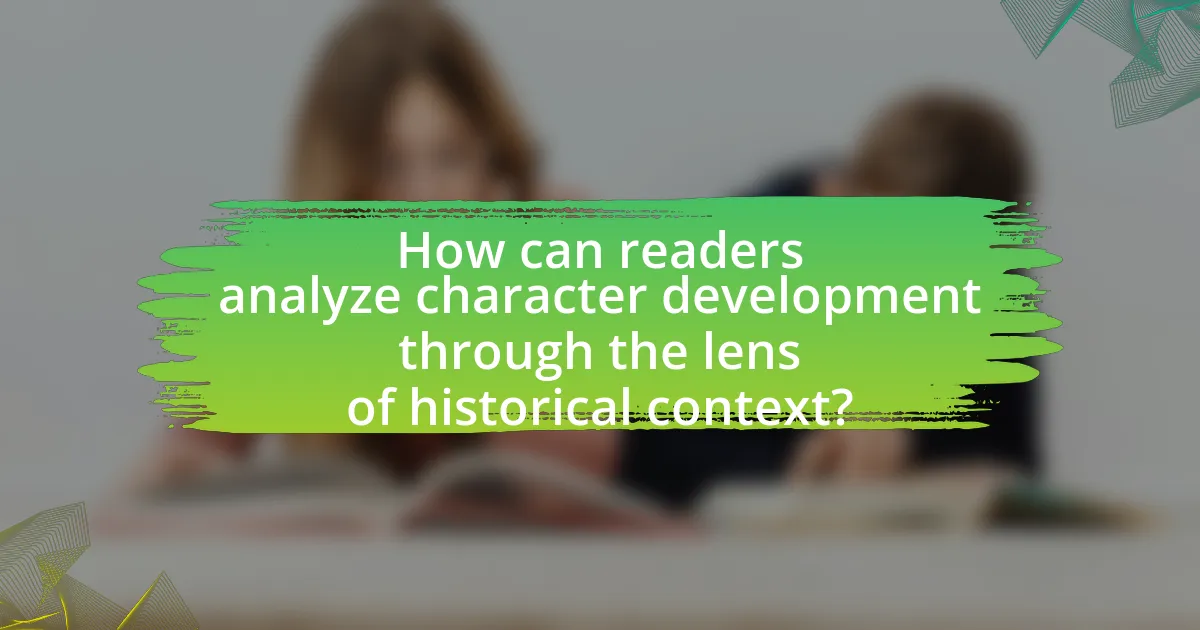The article examines the significant impact of historical context on character development in classic literature, highlighting how societal norms, political climates, and historical events shape characters’ motivations, behaviors, and identities. It discusses specific examples from works by authors such as Charles Dickens and Jane Austen, illustrating how class distinctions and gender roles influence character arcs. The article emphasizes the importance of understanding historical context for accurate character analysis and interpretation, detailing various literary techniques that authors use to reflect these influences. Additionally, it provides strategies for readers to assess historical influences on characters and the consequences of ignoring such context in literary critiques.

What is the Impact of Historical Context on Character Development in Classic Literature?
Historical context significantly influences character development in classic literature by shaping the motivations, behaviors, and societal roles of characters. For instance, in Charles Dickens’ “Great Expectations,” the class distinctions and social expectations of Victorian England profoundly affect Pip’s aspirations and moral dilemmas. The historical backdrop of industrialization and class struggle informs Pip’s journey from a humble upbringing to wealth, illustrating how societal norms dictate personal identity and growth. Similarly, in Jane Austen’s “Pride and Prejudice,” the Regency era’s gender roles and marriage customs critically shape Elizabeth Bennet’s character, highlighting her resistance to societal pressures. These examples demonstrate that understanding the historical context is essential for comprehending character arcs and thematic depth in classic literature.
How does historical context influence character traits in classic literature?
Historical context significantly influences character traits in classic literature by shaping the values, beliefs, and social norms that characters embody. For instance, in Jane Austen’s “Pride and Prejudice,” the character of Elizabeth Bennet reflects the constraints and expectations of early 19th-century British society, particularly regarding gender roles and class distinctions. This historical backdrop informs her assertiveness and desire for personal agency, contrasting with the submissive roles typically assigned to women of her time. Similarly, in Charles Dickens’ “Great Expectations,” the character of Pip is molded by the class struggles and industrialization of Victorian England, which drive his aspirations and moral dilemmas. These examples illustrate how the historical context not only provides a framework for character development but also enriches the narrative by highlighting the interplay between individual traits and societal influences.
What specific historical events shape character motivations?
Specific historical events that shape character motivations include the French Revolution, which instilled themes of liberty and social justice in characters like Jean Valjean in Victor Hugo’s “Les Misérables.” The Industrial Revolution influenced characters in Charles Dickens’ works, such as Oliver Twist, highlighting struggles against poverty and class disparity. Additionally, World War II shaped motivations in literature, as seen in works like “The Book Thief” by Markus Zusak, where characters grapple with the moral complexities of survival under oppressive regimes. These events provide a backdrop that informs characters’ desires, conflicts, and growth, illustrating how historical context directly influences their motivations.
How do societal norms of a particular era affect character behavior?
Societal norms of a particular era significantly shape character behavior by dictating acceptable actions, beliefs, and values within that context. For instance, in Victorian England, strict moral codes influenced characters to exhibit restraint and propriety, as seen in the works of authors like Charles Dickens and George Eliot, where characters often grapple with societal expectations. These norms create internal conflicts, driving character development as individuals navigate their desires against societal pressures. Historical context, such as the Industrial Revolution, further impacts character behavior by introducing themes of class struggle and social mobility, compelling characters to adapt or resist the prevailing norms.
Why is understanding historical context crucial for character analysis?
Understanding historical context is crucial for character analysis because it provides insight into the motivations, behaviors, and societal norms that shape characters within their specific time periods. For instance, characters in classic literature often reflect the values and conflicts of their era, such as the class struggles depicted in Charles Dickens’ works, which are rooted in the Victorian social structure. This context allows readers to interpret characters’ actions and decisions more accurately, as they are influenced by the historical events and cultural attitudes of their time. Therefore, analyzing characters without considering their historical backdrop can lead to misinterpretations of their significance and complexity.
What role does historical context play in reader interpretation?
Historical context significantly influences reader interpretation by providing the backdrop against which characters and events are understood. This context shapes the values, beliefs, and societal norms of the time, allowing readers to grasp the motivations and actions of characters more deeply. For instance, understanding the Victorian era’s strict social codes enhances the interpretation of characters in works like “Pride and Prejudice,” where societal expectations dictate personal choices. Such historical insights enable readers to appreciate the complexities of character development and the narrative’s themes, ultimately leading to a richer and more nuanced reading experience.
How can historical context enhance the depth of character studies?
Historical context enhances the depth of character studies by providing a framework that informs characters’ motivations, behaviors, and societal roles. For instance, understanding the Victorian era’s strict social norms allows readers to better comprehend the constraints faced by characters in works like “Jane Eyre” by Charlotte Brontë, where class and gender significantly influence character development. Additionally, historical events, such as the American Civil War, shape characters in literature like “The Red Badge of Courage” by Stephen Crane, where the realities of war impact the protagonist’s psychological journey. This contextual knowledge deepens the reader’s engagement and interpretation of characters, making their experiences more relatable and nuanced.

What are the key elements of historical context in classic literature?
The key elements of historical context in classic literature include the socio-political environment, cultural norms, economic conditions, and technological advancements of the time. These elements shape the characters, themes, and narratives within the literature, influencing how characters respond to their circumstances. For example, the socio-political climate during the Victorian era, characterized by strict social hierarchies and moral codes, profoundly impacted the character development in works like Charles Dickens’ “Great Expectations,” where class struggles and personal ambition are central themes. Additionally, the cultural norms of the time dictate the behaviors and expectations of characters, as seen in Jane Austen’s novels, which reflect the gender roles and marriage customs of the early 19th century. Economic conditions, such as the Industrial Revolution, also play a crucial role, as they alter the landscape in which characters operate, affecting their opportunities and challenges. Lastly, technological advancements influence the narrative style and accessibility of literature, shaping how stories are told and received by audiences.
How do political and social climates impact character development?
Political and social climates significantly influence character development by shaping individuals’ beliefs, motivations, and actions. For instance, during times of political upheaval, characters often exhibit traits such as resilience or rebellion, reflecting the societal pressures they face. A concrete example is found in Charles Dickens’ “A Tale of Two Cities,” where the characters’ development is deeply intertwined with the French Revolution’s social and political turmoil, illustrating how external circumstances can drive personal transformation and moral choices. This connection between character and context highlights the profound impact that historical events have on individual identities and narratives.
What examples illustrate the influence of political upheaval on characters?
Political upheaval significantly influences characters in classic literature, as seen in works like “Les Misérables” by Victor Hugo and “A Tale of Two Cities” by Charles Dickens. In “Les Misérables,” the character Jean Valjean is shaped by the social injustices and revolutionary fervor of post-revolutionary France, leading him to seek redemption and justice. Similarly, in “A Tale of Two Cities,” Charles Darnay and Sydney Carton are profoundly affected by the French Revolution, which drives their actions and moral choices, illustrating how the chaos of political change can lead to personal transformation and sacrifice. These examples demonstrate that political upheaval serves as a catalyst for character development, revealing deeper themes of morality, justice, and human resilience.
How do social hierarchies and class structures shape character arcs?
Social hierarchies and class structures significantly shape character arcs by influencing motivations, conflicts, and transformations within narratives. Characters often navigate societal expectations and limitations imposed by their class, which can drive their decisions and relationships. For instance, in Charles Dickens’ “Great Expectations,” Pip’s journey from a lower-class boy to a gentleman illustrates how social mobility impacts his identity and moral compass, reflecting the rigid class distinctions of Victorian England. This transformation is further complicated by his interactions with characters like Estella and Magwitch, who embody different aspects of the class system. Such dynamics reveal how characters are often defined and constrained by their social standing, ultimately leading to growth or downfall based on their responses to these pressures.
What literary techniques highlight the impact of historical context on characters?
Literary techniques such as symbolism, foreshadowing, and historical allusion effectively highlight the impact of historical context on characters. Symbolism allows authors to imbue characters with traits or experiences that reflect the societal norms and values of their time, such as the use of the green light in “The Great Gatsby” to symbolize the American Dream and its unattainability during the 1920s. Foreshadowing can reveal how historical events shape character decisions and fates, as seen in “A Tale of Two Cities,” where the impending revolution influences the characters’ actions and motivations. Historical allusion connects characters to real events, enhancing their depth and relatability; for instance, references to the Civil War in “Beloved” underscore the lasting effects of slavery on identity and relationships. These techniques collectively demonstrate how characters are shaped by their historical contexts, providing readers with a deeper understanding of their motivations and struggles.
How do authors use symbolism to reflect historical influences on characters?
Authors use symbolism to reflect historical influences on characters by embedding objects, actions, or motifs that represent broader societal issues or historical events within their narratives. For instance, in “The Great Gatsby,” F. Scott Fitzgerald employs the green light as a symbol of the American Dream, reflecting the post-World War I disillusionment and the socio-economic disparities of the 1920s. This symbolism illustrates how characters like Gatsby are shaped by their aspirations and the historical context of their time, highlighting the tension between idealism and reality. Such symbolic representations allow readers to understand the characters’ motivations and struggles in relation to the historical backdrop, thereby deepening the narrative’s thematic complexity.
What narrative styles effectively convey historical context in character development?
First-person and third-person omniscient narrative styles effectively convey historical context in character development. The first-person perspective allows characters to share personal experiences and emotions directly tied to historical events, creating an intimate connection between the character’s development and the socio-political landscape of the time. For example, in “The Diary of Anne Frank,” the first-person narrative provides insight into the impact of World War II on Anne’s growth and identity.
Third-person omniscient narration offers a broader view, allowing the author to explore multiple characters’ experiences and how they are shaped by historical contexts. In “War and Peace,” Leo Tolstoy employs this style to illustrate how the Napoleonic Wars influence the lives and decisions of various characters, thereby enriching their development against the backdrop of significant historical events. Both styles enhance the reader’s understanding of how history shapes individual identities and relationships.

How can readers analyze character development through the lens of historical context?
Readers can analyze character development through the lens of historical context by examining how the societal norms, values, and events of a specific time period influence a character’s actions, motivations, and growth. For instance, in Charles Dickens’ “Great Expectations,” the character of Pip evolves in response to the class distinctions and industrial changes of 19th-century England, reflecting the historical context of social mobility and economic disparity. This connection between Pip’s development and the historical backdrop illustrates how external factors shape individual experiences and character arcs, providing a deeper understanding of the narrative.
What strategies can be employed to assess historical influences on characters?
To assess historical influences on characters, one effective strategy is to conduct a contextual analysis of the time period in which the characters exist. This involves examining historical events, social norms, and cultural values that shaped the characters’ motivations and actions. For instance, understanding the impact of the Industrial Revolution on characters in Charles Dickens’ works reveals how economic changes influenced social class dynamics and personal relationships. Additionally, literary criticism techniques, such as historical-biographical criticism, can provide insights into how an author’s life experiences and the historical context influenced character development. By analyzing primary historical documents and secondary scholarly sources, researchers can draw connections between the characters’ traits and the prevailing historical circumstances, thereby validating the assessment of historical influences on character development.
How can comparative analysis of characters across different historical contexts enhance understanding?
Comparative analysis of characters across different historical contexts enhances understanding by revealing how societal norms, values, and conflicts shape character motivations and actions. For instance, examining characters from the Victorian era, such as Elizabeth Bennet in “Pride and Prejudice,” alongside characters from the post-war period, like Holden Caulfield in “The Catcher in the Rye,” illustrates how differing cultural expectations influence personal identity and social interactions. This analysis highlights the impact of historical events, such as the Industrial Revolution and World War II, on character development, demonstrating that characters are not only products of their time but also reflections of the evolving human experience. By contrasting these characters, readers gain insights into the complexities of human behavior and the ways in which historical context informs literature.
What resources are available for researching historical context in literature?
Resources available for researching historical context in literature include academic databases, historical texts, and literary criticism journals. Academic databases such as JSTOR and Project MUSE provide access to scholarly articles that analyze the relationship between historical events and literary works. Historical texts, including primary sources like letters, diaries, and newspapers from the relevant period, offer firsthand accounts that illuminate the context in which a literary piece was created. Additionally, literary criticism journals often publish analyses that explore how historical context influences character development and themes in classic literature, providing concrete examples and interpretations that support the understanding of the text within its historical framework.
What are the common pitfalls in analyzing character development without historical context?
Analyzing character development without historical context often leads to misinterpretation of motivations and actions. Characters are shaped by the societal norms, values, and events of their time, which influence their decisions and growth. For instance, a character’s behavior in a Victorian novel may be misunderstood if the reader does not consider the strict social codes of that era. Additionally, ignoring historical context can result in anachronistic judgments, where modern values are improperly applied to past characters, leading to skewed analyses. This lack of context can also overlook significant influences such as class struggles, gender roles, and cultural expectations that are pivotal to understanding a character’s journey.
How can ignoring historical context lead to misinterpretation of characters?
Ignoring historical context can lead to misinterpretation of characters by obscuring their motivations, values, and actions that are deeply rooted in the societal norms and events of their time. For example, a character in a novel set during the Victorian era may be judged by contemporary standards of morality, leading to a misunderstanding of their decisions and behaviors that were acceptable in their historical context. This misinterpretation can result in anachronistic readings, where modern perspectives distort the original intent and significance of the character’s role within the narrative. Historical context provides essential insights into the character’s environment, influencing their development and the choices they make, which are often reflective of the complexities of their time.
What are the consequences of anachronistic readings of classic literature?
Anachronistic readings of classic literature can lead to significant misinterpretations of characters and themes. When readers impose contemporary values or beliefs onto historical texts, they risk distorting the author’s original intent and the societal context in which the work was created. For instance, interpreting Shakespeare’s “The Merchant of Venice” solely through a modern lens of racial equality overlooks the complexities of 16th-century attitudes toward ethnicity and commerce, which are crucial for understanding character motivations and societal critiques. This misalignment can result in a superficial understanding of the text, diminishing its literary value and relevance.
What practical tips can enhance the analysis of character development in classic literature?
To enhance the analysis of character development in classic literature, readers should focus on understanding the historical context in which the work was created. This involves researching the author’s background, the societal norms of the time, and the specific events that may have influenced character motivations and behaviors. For instance, examining the Victorian era’s strict social codes can provide insight into the characters in Charles Dickens’ works, revealing how societal expectations shape their actions and relationships. Additionally, comparing characters across different works from the same period can highlight common themes and character archetypes, further enriching the analysis.
How can readers effectively integrate historical context into their literary critiques?
Readers can effectively integrate historical context into their literary critiques by analyzing the socio-political, economic, and cultural conditions of the time when the work was written. This approach allows readers to understand how these factors influence character motivations, themes, and narrative structures. For instance, examining the Victorian era’s strict social norms can illuminate the constraints faced by characters in works like “Jane Eyre” by Charlotte Brontë, where issues of class and gender play pivotal roles. Historical context provides a framework that enriches the critique, revealing deeper meanings and connections that may not be immediately apparent without this background knowledge.
What best practices should be followed when studying character development in relation to historical context?
When studying character development in relation to historical context, it is essential to analyze the socio-political environment of the time period in which the work was created. This involves examining historical events, cultural norms, and prevailing ideologies that influence character motivations and behaviors. For instance, understanding the impact of the Industrial Revolution on characters in Victorian literature reveals how economic changes shaped individual identities and societal roles. Additionally, comparing characters across different historical contexts can highlight how similar traits manifest differently due to varying societal expectations. This approach is validated by literary scholars who emphasize the importance of context in interpreting character actions and growth, as seen in works like “The Historical Imagination in Nineteenth-Century Britain” by David Green and “Character and the Historical Novel” by John W. Aldridge.





